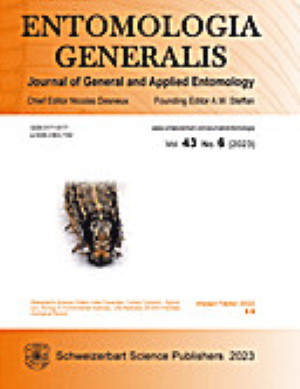Lobularia maritima 作为 Tuta absoluta 的两种寄生蜂的营养丰富的花食物源
IF 4.6
1区 农林科学
Q1 ENTOMOLOGY
引用次数: 0
摘要
Tuta absoluta (Meyrick) (鳞翅目:Gelechiidae)是威胁全球番茄生产的主要害虫之一。自从在地中海盆地被发现以来,它一直是旨在减少番茄作物损害的研究目标。目前的保护性生物防治方法主要集中在多食性捕食者 Macrolophus pygmaeus (Rambur) 和 Nesidiocoris tenuis (Reuter)(半翅目:Miridae),它们是该害虫卵的有效捕食者,但对 T. absoluta 幼虫的影响很小。在西班牙东北部进行的调查得出结论,鞘翅目昆虫 Necremnus tutae Ribes & Bernardo 和腕翅目昆虫 Dolichogenidea gelechiidivoris (Marsh) 是数量最多的幼虫寄生虫。众所周知,在作物附近增加花卉资源可为天敌提供优质食物,从而加强生物防治。以前的研究表明,Lobularia maritima L.(十字花科)花是 N. tutae 可靠的食物来源。本研究探讨了 L. maritima 花的可用性是否会对 D. gelechiidivoris 的适应性以及寄生虫对 T. absoluta 的生物防治产生积极影响。为了研究这一方面,我们分别在T. absoluta密度较高和较低的简单和复杂环境中对两种黄蜂的表现进行了评估。我们的研究结果表明,L. maritima 的花蜜是 N. tutae 和 D. gelechiidivoris 营养丰富的食物来源,对番茄中 T. absoluta 的生物防治具有深远影响。本文章由计算机程序翻译,如有差异,请以英文原文为准。
Lobularia maritima as a nutrient-rich floral food source for two parasitoid wasps of Tuta absoluta
Tuta absoluta (Meyrick) (Lepidoptera: Gelechiidae) is one of the main pests threatening tomato production worldwide. Since its detection in the Mediterranean basin, it has been the target of research aiming to reduce damage in tomato crops. Current conservation biological control approaches focus on the polyphagous predators Macrolophus pygmaeus (Rambur) and Nesidiocoris tenuis (Reuter) (Hemiptera: Miridae), which are very effective predators of the pest’s eggs but have little effect on T. absoluta larvae. Surveys conducted in northeast of Spain have concluded that the eulophid Necremnus tutae Ribes & Bernardo and the braconid Dolichogenidea gelechiidivoris (Marsh) are the most abundant larval parasitoids. It is well known that adding floral resources near crops can provide high-quality food for natural enemies and thus enhance biological control. Previous studies showed that Lobularia maritima L. (Brassicaceae) flowers are a reliable food source for N. tutae. The present study examines whether the availability of L. maritima flowers positively influences the fitness of D. gelechiidivoris and the biological control of T. absoluta by parasitoids. To study this aspect, the performance of both wasps was evaluated in a simple and complex arena at high and low densities of T. absoluta, respectively. Our results demonstrate that the nectar of L. maritima is a nutrient-rich food source for both N. tutae and D. gelechiidivoris with profound implications on the biological control of T. absoluta in tomatoes.
求助全文
通过发布文献求助,成功后即可免费获取论文全文。
去求助
来源期刊

Entomologia Generalis
生物-昆虫学
CiteScore
7.10
自引率
18.80%
发文量
72
审稿时长
>12 weeks
期刊介绍:
Its scope covers all aspects of basic and applied research dealing with insects and more broadly with arthropods inhabiting wild, agricultural and/or urban habitats. The journal also considers research integrating various disciplines and issues within the broad field of entomology and ecology.
Entomologia Generalis publishes high quality research articles on advances in knowledge on the ecology and biology of arthropods, as well as on their importance for key ecosystems services, e.g. as biological control and pollination. The journal devotes special attention to contributions providing significant advances (i) on the fundamental knowledge and on sustainable control strategies of arthropod pests (including of stored products) and vectors of diseases, (ii) on the biology and ecology of beneficial arthropods, (iii) on the spread and impact of invasive pests, and (iv) on potential side effects of pest management methods.
Entomologia Generalis welcomes review articles on significant developments in the field of entomology. These are usually invited by the editorial board, but proposals may be sent to the Editor-in-Chief for preliminary assessment by the editorial board before formal submission to the journal. The journal also considers comments on papers published in Entomologia Generalis, as well as short notes on topics that are of broader interest.
 求助内容:
求助内容: 应助结果提醒方式:
应助结果提醒方式:


